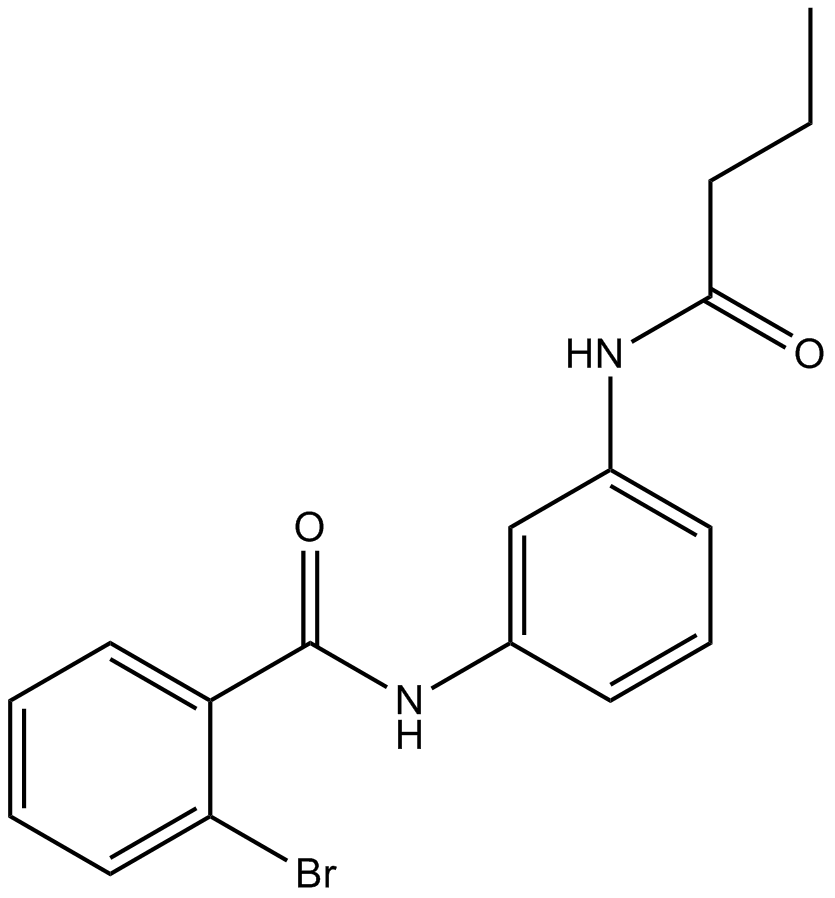SLIGKV-NH2
IC50: A protease-activated receptor 2 (PAR2) agonist with an IC50 of 10.4 M.
SLIGKV-NH2 serves as a protease-activated receptor 2 (PAR2) agonist. PARs are a group of G-protein-coupled receptors existing in several cell types. Up to date, four PAR members including PAR1 to 4 have been identified, cloned and designated. PAR2 is expressed in the respiratory and gastrointestinal tracts. It is suggested that the activation of PAR2 is closely correlated with inflammatory evens in various cells and tissues. PAR2 has also been identified to induce protease activation and therefore result in systemic hypotension. [1]
In vitro: It was reported that SLIGKV-NH2 (the PAR2 activating peptide), by inducing express of PAR2, could slightly enhanced mucin secretion by human bronchial epithelial cells in vitro. According to this study, compared to cells treated with a control peptide with reversed amino acid sequence, exposure of cells to SLIGKV-NH2 for 30 mins resulted in a weak but statistically significant increase in mucin secretion at concentrations of 100 and 1000M. In addition, SLIGKV-NH2 was demonstrated to accelerate cell cycle progression and stimulate the growth of HepG2 cells. [1, 2]
In vivo: The ability of PAR2 agonists to induce contractile responses was investigated in vivo. It was found that mouse PAR2 activating (SLIGRL-NH2) and human PAR2 activating (SLIGKV-NH2) peptides triggered a concentration-dependent contractile response in guinea-pig gallbladder. [3]
Clinical trial: PAR2 activating peptide, SLIGKV-NH2, and its reverse-sequence control peptide VKGILS-NH2 were synthesized to verify the hypothesis that in vivo activation of PAR2 in humans would cause vasodilatation. The result of this study showed that, in forearm resistance vessels, SLIGKV-NH2 triggered a dose-dependent dilatation, while VKGILS-NH2 had no significant effect. [4]
References:
[1] Lin KW, Park J, Crews AL, Li YH, Adler KB. Protease-activated receptor-2 (PAR-2) is a weak enhancer of mucin secretion by human bronchial epithelial cells in vitro. Int J Biochem Cell B. 2008. 40: 137988.
[2]Xie L, Zheng Y, Li X, Zhao JY, Chen XY, Chen L, Zhou J, Hai O and Li F. Enhanced proliferation of human hepatoma cells by PAR-2 agonists via the ERK/AP-1 pathway. Oncol Rep. 2012.28: 1665-72.
[3] Tognetto M, Trevisani M, Maggiore B, Navarra G, Turini A, Guerrini R, Bunnett NW, Geppetti P and Harrison S. Evidence that PAR-1 and PAR-2 mediate prostanoid-dependent contraction in isolated guinea-pig gallbladder. Br.J.Pharmacol. 2000.131: 689-94.
[4] Robin J, Kharbanda R, Mclean P, Campbell R, Vallance P. Protease-activated receptor 2–mediated vasodilatation in humans in vivo, role of nitric oxide and prostanoids. Circulation. 2003;107:954-959.
| Physical Appearance | White lyophilised solid |
| Storage | Desiccate at -20°C |
| M.Wt | 614.78 |
| Cas No. | 190383-13-2 |
| Formula | C28H54N8O7 |
| Solubility | ≥13.48 mg/mL in EtOH with gentle warming and ultrasonic; ≥62.9 mg/mL in DMSO; ≥66.2 mg/mL in H2O |
| Chemical Name | (2S)-6-amino-2-[[2-[[(2S,3S)-2-[[(2S)-2-[[(2S)-2-amino-3-hydroxypropanoyl]amino]-4-methylpentanoyl]amino]-3-methylpentanoyl]amino]acetyl]amino]-N-[(2S)-1-amino-3-methyl-1-oxobutan-2-yl]hexanamide |
| SDF | Download SDF |
| Canonical SMILES | CCC(C)C(C(=O)NCC(=O)NC(CCCCN)C(=O)NC(C(C)C)C(=O)N)NC(=O)C(CC(C)C)NC(=O)C(CO)N |
| Shipping Condition | Small Molecules with Blue Ice, Modified Nucleotides with Dry Ice. |
| General tips | We do not recommend long-term storage for the solution, please use it up soon. |
Quality Control &MSDS
- View current batch:
-
Purity = 99.16%
- COA (Certificate Of Analysis)
- HPLC
- MS
- MSDS (Material Safety Data Sheet)
- Datasheet
Chemical structure













